Time to write some love letters to the shiny gems sitting atop this garbage year!
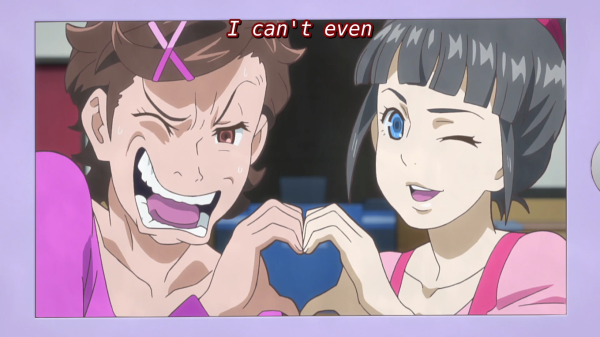
Given that 2017 lasted about thirty normal years (I’m pretty sure I’m eligible for senior citizen discounts now), perhaps it’s no wonder that we were able to cram so many great anime into it. As with 2016, I’ve decided to throw even the veneer of objectivity out the window and just talk to you about some shows I really loved or think are worthy of highlighting.
This also means a metric ton of “Honorable Mentions” so I could give some love to the shows that just barely missed the cut. Top 10, Top 15… listen, time is clearly an illusion, so why can’t yearly rankings be?
As a reminder, while I tend to play this list pretty free-and-easy, there are two rules I do keep: (1) Shorts aren’t eligible for the Top 10, and (2) while shows with 2018 sequels (like My Hero Academia) are eligible for the list, carryovers and split-cours that are scheduled to finish in 2018 are not. So, as a fun example of how this works: ClassicaLoid Season 1 is eligible, but ClassicaLoid Season 2 isn’t.
And now that we’ve gotten the boring explanations out of the way…
Honorable Mentions
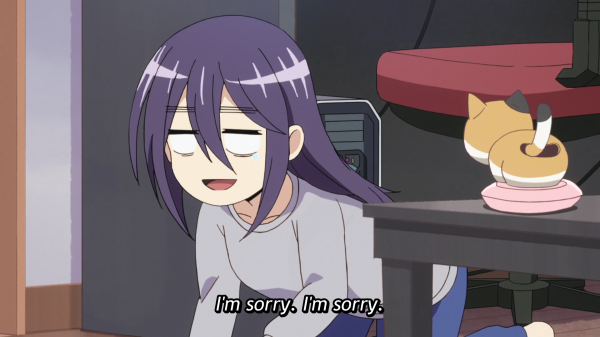
A.K.A. The Fun Categories, A.K.A. Where Everyone Judges Me For My Bad Taste!
Best Show Late to the Party: The Great Passage. While it technically aired in 2016 and so isn’t eligible for the list itself, Amazon sat on the license so long that I couldn’t actually watch it until 2017. Once I finally did, I was treated to a quiet, pensive show about the importance of communication, the value of finding a project you’re passionate about, and an adult man being moe as hell. It’s a low-key series that I never quite fell in love with, but it’s a thoughtful, well-made work that’s still worth your time.
Best Trash: Vatican Miracle Examiner, a.k.a. Vatican Bros. A hilaribad trainwreck of stupid mysteries and wild plot twists, Vatican Bros was one of the shows I most looked forward to watching (and livetweeting) each week. The first arc—a four-episode off-the-wall ride involving everything and the kitchen sink—is not to be missed. Grab a drink and some friends and have fun.
Show Most In Need of a Sequel: Princess Principal. With such a haphazard, open-ended conclusion and no promise of a sequel (or even an ongoing manga or novel to read), I couldn’t quite justify placing it in my Top 10. Even so, it featured a great cast, fun world, and one of my favorite anime episodes of the season, a cheerfully feminist tale of women supporting each other in the workplace. I’ll keep my fingers crossed that it somehow manages to return for another round of adventures. Stranger things have happened, right?
Best Shows That Aren’t On This List Because My Taste Is Bad and I Should Feel Bad: Ahh, my very favorite category, where I highlight two good series that got nudged out so I could give spots to personal darlings instead. This year the award goes to a pair of very different shows: My Hero Academia Season 2 and Recovery of an MMO Junkie.
If MHA had only been the first 13 episodes, it would have cleared my top 10 handily, but some of the shine came off in its second act thanks to some crappy “jokes” about catty women and the series trying to make me sympathize with the group’s resident sexual harasser. I still enjoyed it, mind you, but I decided to use this list to shower love on some series you maybe haven’t heard of instead. MHA will be back next year, so it has time to crack my list again.
As for MMO Junkie… I talked about this in my Fall Season Retrospective, but suffice to say a few lingering issues meant I liked it but could never quite love it, and the fact that I really wanted to love it made that all the more disappointing. It still deserves lots of accolades for depicting an adult female NEET as a sympathetic protagonist and arguing for the validity of online communities as healthy support networks, so please do check it out. There were just 10 other series I preferred, is all. Like I said, it was a good year for anime.
So then what did earn one of those top spots? Get your shocked comments ready, ’cause here comes the first wave of titles!
10. The Royal Tutor (Oushitsu Kyoushi Heine)
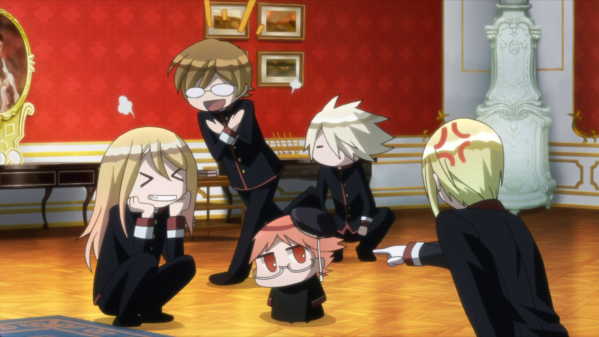
Episode Count: 12
Studio: Bridge
Series director: Kikuchi Katsuya
In a sentence: Pint-sized tutor Heine Wittgenstein is brought in to teach the four youngest princes, a task that proves trickier than he’d first thought.
Content warning: Bullying; mild fanservice (male)
As is tradition, the #10 spot always goes to an under-the-radar series I adored, and so perhaps it’s no surprise that this year I’m giving that honor to my good good boys and their deadpan professor. I wrote weekly commentaries on The Royal Tutor for Anime Evo and made no effort to hide my love of the series. This cute, silly comedy filled me with joy and giggles just about every week, and even managed to hit some heartwarming emotional beats along the way.
I’d expected it to be a fun watch right from the start, but what I hadn’t expected was how much meat was gonna be on these chibi bones. Over the course of the series, The Royal Tutor impressed me with its optimistic-but-nuanced look at privilege, prejudice, and class differences, as well as the way its characters dealt with anxiety (both social and academic), public expectations, and self-doubt. It was also the most focused series thematically of the year, finding a way to tie its favorite message—never judge a book by its cover—into the story just about every week.
Despite an underwhelming two-part anime-original finale, The Royal Tutor is still a series very close to my heart. It’s bright and silly and thoughtful and sweet, and charmed me so thoroughly that I immediately went out and bought the first volume of the manga. If that ain’t a glowing recommendation, I don’t know what is.
The Royal Tutor is licensed by and streaming on Crunchyroll (sub) and Funimation (dub). Check to see if it’s available in your region.
9. Kabukibu!
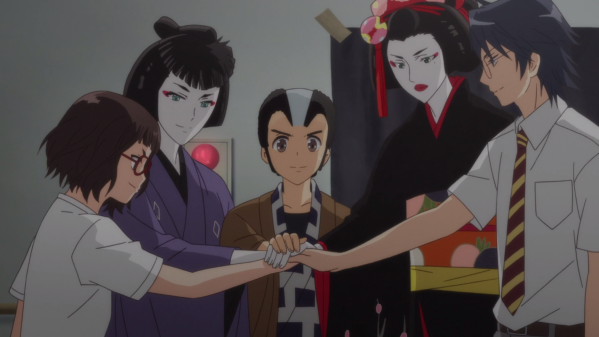
Episode Count: 12
Studio: DEEN
Series director: Yoneda Kazuhiro
In a sentence: High schooler Kurogo Kurusu gathers together a diverse group of students to form a kabuki performance club so he can share his passion with others.
I didn’t watch this one while it was airing, so this is my first time really getting a chance to talk about it. Once I did finally get to it, I binged it in under 24 hours. This school story about a kabuki-loving teenager and the club he puts together was a pleasant surprise—and so far up my alley it came through my front door and helped itself to a cup of coffee.
Upbeat tone and even balance of the comedic and the sincere? Check. A group of likable, diverse kids who grow as a community and directly challenge gender norms and cultural traditions? Check. A narrative centered around an earnest love of an obscure performance art that also does a really good job teaching its audience about that performance art? Check and double-check. It’s basically Rakugo Shinju Lite, and I mean that in the most positive way possible.
While Kabukibu has a solid narrative through-line about the club coming together and putting on their first school performance, it’s still an adaptation of an ongoing light novel series, meaning there are some hanging threads particularly in terms of character arcs. In other words: Please join me in pestering Yen Press to publish the LNs. This hidden gem has more story to tell, and I very much want to hear it.
Kabukibu is licensed by Sentai and is streaming on HiDIVE and Amazon. Check to see if it’s available in your region.
8. Made in Abyss
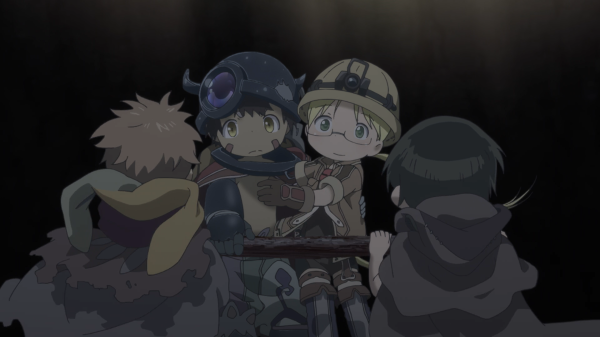
Episode Count: 13
Studio: Kinema Citrus
Series director: Kojima Masayuki
In a sentence: In a town that overlooks a massive abyss, a young Raider-in-training goes searching for “Relics” and finds a robot boy instead.
Content warning: Violence (some graphic, involving kids); nudity
This was originally slated for my Top 5, but the more I thought about it the more I realized its negative points had left a more sour taste than I’d expected. So it wound up down here instead.
At its best, MiA was Top 3 material, but at its worst… well, the series has some real problems, particularly an over-reliance on nudity and bodily functions to help convey its themes of “de-romanticizing adventure narratives,” “descending into the natural world,” and “coming to terms with your own mortality” (these are all Good Themes, by the way; the series just over-uses certain devices to the point where it becomes fetishistic or skeevy). It also toes the line between “pain with a purpose” and “torture porn” at times, and I could see folks reading it as more the latter than the former.
Even so, it’s a beautifully complete production in terms of art design, animation, and music. It toys with gender norms (my Achilles heel), including two female mentor-figures and a couple of gender-ambiguous characters. The cast is packed with well-realized individuals with unique strengths and goals with whom I deeply sympathize if not outright love. I think Riko’s cleverness and willpower are an inspiration, and I will fight for the value of characters who are both admirable figures and non-combatants. Also, the finale turned me into a puddle of tears.
My own love of it may be waning as I get further from the experience of watching it week-to-week, but it’s still a series that captivated me each episode, and one I think is trying to say something valuable about adolescence and adventure stories. I’ll be eagerly awaiting more of this ongoing story, as I’m fully invested and very much want to know what harrowing, heartbreaking, or quietly inspiring adventures these kids go on next.
Made in Abyss is licensed by Sentai and is streaming on HiDIVE and Amazon. Check to see if it’s available in your region.
7. Natsume’s Book of Friends – Season 6 (Natsume Yujin-cho Roku)
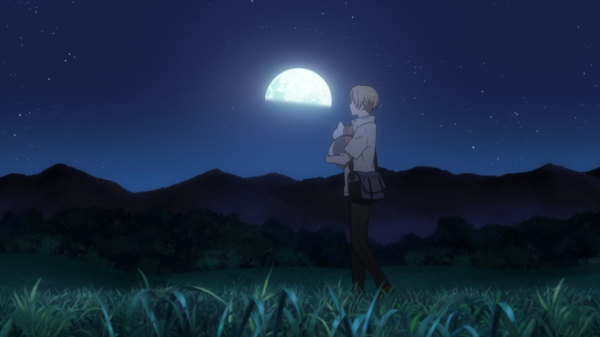
Season Episode Count: 12
Series Episode Count: 74 + some OVAs
Studio: Shuka
Season Director: Deai Kotomi
In a sentence: Natsume has always considered his ability to see youkai as a curse, but when he comes across his grandmother’s book of youkai names (“The Book of Friends”), his experiences and outlook slowly begin to change.
Content Warning: Mild violence; some (restrained) depictions of child abuse
A friend and I watched the entirety of Natsume’s Book of Friends over the past year-ish, making this the first time I’ve been able to put the series on a Top 10 list. And boy, am I happy to do it.
Natsume is a masterclass in both episodic and slow-burn storytelling. Practically every episode is a self-contained story and there’s nary a dud among them, each finding new ways to explore the show’s central themes about empathy, community, love, loss, and the ephemeral nature of human existence. It also (very!) slowly develops a broader narrative, as Natsume builds friendships with humans and youkai alike, comes to learn more about his grandmother and the spiritual world around him, and begins the gradual process of healing from years of neglect and isolation.
To describe it as “low-key” isn’t exactly right, because it frequently punches you right in the emotions—my friend’s eyes were perpetually misty and even Your Hardened (pfft) Blogger got choked up from time to time—but it does so with gentle understatement. Natsume’s Book of Friends is a lovely, graceful tale of found families and emotional recovery. It’s 74 episodes long and I’d still happily soak in more of it.
Natsume’s Book of Friends is licensed by and streaming on Crunchyroll. Check to see if it’s available in your region.
6. Scum’s Wish (Kuzu no Honkai)
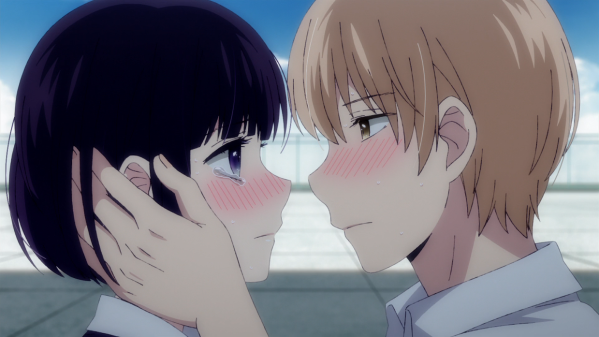
Episode Count: 12
Studio: Lerche
Series director: Ando Masaomi
In a sentence: This raw high school story explores the complicated bonds (both emotional and physical) between four students and two teachers as they try to figure out what “love” and “happiness” mean to them.
Content Warning: Sex; nudity; teacher/student relationship
Another series I binged after the fact, though I spaced this one out over a full week instead of 24 hours. I used the word “raw” in my summary, and that’s what I keep coming back to with this show. Scum’s Wish is difficult, visceral, and intentionally uncomfortable, but also one of the most ambitious and, I think, important shows of the year.
It strips away the glossy veneer of so much high school-focused fiction, eschewing cutesy antics, melodramatic tragedies, shoehorned miscommunication, or pat endings. Instead, Scum’s Wish digs into the messiness of adolescence as both emotions and physical desire run high and people try to balance their own wants with those of others. It’s one of the most straightforward portrayals of teen sexuality I’ve seen in any medium, as well as a great example of how to frame sex without objectifying your characters.
There is one major caveat: There’s a teacher/student relationship in the back half, and while it’s pretty explicitly depicted as fucked up, the teacher is ultimately portrayed as pathetic instead of villainous and doesn’t receive any comeuppance. I can appreciate a show that refuses to paint anyone as a two-dimensional monster, but it’s still deeply uncomfortable and unsatisfying, and I can imagine it triggering people who have been involved in similarly abusive relationships.
That said, Scum’s Wish still handled its teenage characters (including a queer girl) with a complexity and openness that we need more of in anime, showing how young people can screw up, hurt others, get hurt themselves, learn, and come out the other side as better people. Despite its focus on sexuality, it tackled the fear of loneliness and desperate need to be needed in a way that even an ace kid like yours truly could relate to. It has some significant flaws, but I still want to applaud it for its honesty and intensity. We need messy, raw stories like this, warts and all.
Scum’s Wish is licensed by Amazon and is streaming on either Prime Video or Anime Strike. Check to see if it’s available in your region.
Click here for Part 2 and my Top 5 of 2017!
If you enjoyed this pipin’ hot plate of anime reviews, please consider tipping your server through PayPal!

I don’t get Made in Abyss’s popularity at all.
Scum’s Wish is part of a trend of Sex in fiction only being respectable if people don’t enjoy or it has horrible consequences. I really can’t get behind it, I recommend Digibro’s video on it.
LikeLike
The vast majority of the sex in Scum’s Wish is enjoyed by both parties (in fact all of the teen relationships are very particular about consent – both Mugi and Ecchan frequently, explicitly offer to stop or encourage Hanabi to tell them if she doesn’t want to do this, and she almost always says she wants to keep going because it “feels good”), and there are no “horrible” consequences. The relationships are a mess but so are most high school relationships, and the kids all ultimately come out the other side more thoughtful and mature people. Two of them maintain a friendship and the other two are grateful for the relationship that they had, even if it didn’t end in happily-ever-after.
It’s fine if you’re not into it, and I won’t pretend that the teacher/student stuff isn’t deeply flawed because it super is, but please don’t paint it with such an over-simplistic and misleading brush. It’s much more nuanced than that.
LikeLike
When a person says they enjoyed but them immediately follow up with how that makes her feel like a horrible person. That’s not really enjoying it.
It sounds like a scene Augustine of Hippo would write, and I really don’t like being reminded of that guy.
LikeLike
Here is a blog post about Scum’s Wish I mostly agree with.
LikeLike
Scum’s Wish taps into a lot of the anxieties that I had about myself and my relationships with others when I was in high school. I know others who have expressed similar sentiments. I appreciate the series for being so raw and honest in its portrayal of those anxieties, and I think it deserves accolades for that.
Clearly you and this blogger had different experiences and the show did not resonate with you in the same way, and that’s fine. Not everything has to be for everybody.
LikeLike
Natsume Yujin-cho Roku and Kuzu no Honkai both make my top ten easily for the year.
You can’t make an honest work about life without people doing bad things and never suffering any consequences. Rawness has its place in the anime world.
Akane’s affair with Mugi is the only fundamentally “bad” thing that happens in the series. She never regrets it and he doesn’t appear devastated by it, which was probably NOT the politically correct way to handle it. She abused a position of power and walked away from it. Mugi still seems to be suffering some long term issues that Hanabi has overcome so you can say harm was done to him, just not soul-crushing harm. Having him OD on drugs in despair or hauling Akane off in cuffs would just be a copout.
As for the rest of the sexuality, welcome to reality. A certain percentage of teenagers will indeed have a lot of sex for various reasons and not all relating to romantic love. I don’t think it is an inherently bad thing. Consensuality is the key.
I blogged about this show this once…
LikeLike